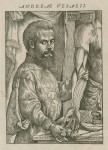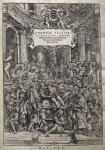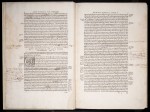 Andreas Vesalius, the 16th century physician from Brussels, is considered the founder of modern anatomy. He revolutionized medicine by introducing hands-on dissection of human cadavers into surgical studies and by exposing the errors of medieval authorities like Mondino de’ Liuzzi, the Arabic translators of ancient Greek and Latin sources, and even the newly revived, translated and mass-printed works of Galen who Vesalius followed in many ways. It was Vesalius’ skill at surgery, already widely recognized by the time he finished his studies, and his dedication to practical anatomical exploration which drove him to correct Galenic misapprehensions caused by his dissection of Barbary macaques instead of people.
Andreas Vesalius, the 16th century physician from Brussels, is considered the founder of modern anatomy. He revolutionized medicine by introducing hands-on dissection of human cadavers into surgical studies and by exposing the errors of medieval authorities like Mondino de’ Liuzzi, the Arabic translators of ancient Greek and Latin sources, and even the newly revived, translated and mass-printed works of Galen who Vesalius followed in many ways. It was Vesalius’ skill at surgery, already widely recognized by the time he finished his studies, and his dedication to practical anatomical exploration which drove him to correct Galenic misapprehensions caused by his dissection of Barbary macaques instead of people.
In 1543, Vesalius published a groundbreaking anatomy textbook: De Humani Corporis Fabrica (On the Fabric of the Human Body). The content was based on his lectures as Chair of Surgery and Anatomy at the University of Padua where he was the first physician to insist on performing his own dissections on human cadavers while students closely observed his work. Before him, lecturers read from accepted authorities while barber-surgeons dissected animals, and a human once a year in winter when the cadaver could last longer. A student of his noted with amazement that Vesalius single-handedly did the work three men — the lecturer, the demonstrator and the dissector — had done before him. He also was the first professor to bring detailed anatomically correct drawings into the class as visual aids to his lectures.
 This innovative approach was reflected in his book as well. De Fabrica wasn’t the first book based on recent explorations of human anatomy, but it was the first to include truly modern, complex anatomical drawings made by skilled artists from the school of Titian who were actually present at dissections. Other anatomical texts had sketches made by the doctors themselves, so not surprisingly they often were little more than symbolic blobs bearing no resemblance to life. Vesalius’ artwork were professional engravings printed by Joannis Oporini of Basel, Switzerland, one of the greatest printers of the age. The engravings were meticulously precise and detailed to a degree never before seen.
This innovative approach was reflected in his book as well. De Fabrica wasn’t the first book based on recent explorations of human anatomy, but it was the first to include truly modern, complex anatomical drawings made by skilled artists from the school of Titian who were actually present at dissections. Other anatomical texts had sketches made by the doctors themselves, so not surprisingly they often were little more than symbolic blobs bearing no resemblance to life. Vesalius’ artwork were professional engravings printed by Joannis Oporini of Basel, Switzerland, one of the greatest printers of the age. The engravings were meticulously precise and detailed to a degree never before seen.
Also represented in De Fabrica is Vesalius’ extensive collection of corrections. For years he had taken notes and published short tracts correcting what he believed were the errors of other anatomists, including living ones like his former teachers Jean Dubois (aka Sylvius) and Johann Guinther von Andernach at the University of Paris. The idea was to create an overview anatomical text along the Galenic model that would fix all the mistakes floating out there and provide evidence not just by argument but also through detailed illustrations.
 De Fabrica was a sensation. It became a standard text almost immediately, and it secured Vesalius a position as a household physician to Holy Roman Emperor Charles V. As exalted a position as this was, at a court that was a center of cultural and scientific patronage, as a member of the emperor’s household, Vesalius’ days as a professor were over, and, he thought, his days as an author were as well. He returned to Padua for a lecture attended by more than 500 students, but that was it. Over the protestations of his friends and colleagues, he also made the insane decision to burn his notes, unpublished works and much of his library, including copies of Galen he had extensively annotated.
De Fabrica was a sensation. It became a standard text almost immediately, and it secured Vesalius a position as a household physician to Holy Roman Emperor Charles V. As exalted a position as this was, at a court that was a center of cultural and scientific patronage, as a member of the emperor’s household, Vesalius’ days as a professor were over, and, he thought, his days as an author were as well. He returned to Padua for a lecture attended by more than 500 students, but that was it. Over the protestations of his friends and colleagues, he also made the insane decision to burn his notes, unpublished works and much of his library, including copies of Galen he had extensively annotated.
He wasn’t quite done writing yet, though. His success at court led to a lucrative private practice in Brussels, and although he traveled with the emperor, in the first half of the 1550s he spent most of his time in his lavish home in Brussels which gave him the opportunity to work on a revision of De Fabrica. This wasn’t a superficial edit. Everything from the typography to the Latin grammar to the placement of the illustrations was made more elegant, more readable. The content was also substantively altered. The new edition would include corrections drawn from his experience at court, tending to war wounds and performing autopsies. The sections on female anatomy, previously heavily reliant on animal dissection, were completely rewritten based on his first-hand knowledge acquired from autopsying the cadavers of pregnant women. He was more secure in his disagreements with Galen and more reliant on his own personal experience rather than his book learning. The result was an edition that was fully rooted in and clearly stated its grounding in hands-on anatomical study of cadavers, that in no uncertain terms prioritized the evidence of scientific examination over the analysis of authorities.
 The second edition of De Humani Corporis Fabrica was published in 1555. Vesalius died in 1564 on his way back from a pilgrimage to the Holy Land. He was two months shy of his 50th birthday. No third edition was ever published, but it seems that in that nine year interim he had planned just that. A copy of the 1555 edition of De Fabrica was recently purchased by a German collector and it contains massive annotations in Vesalius’ hand.
The second edition of De Humani Corporis Fabrica was published in 1555. Vesalius died in 1564 on his way back from a pilgrimage to the Holy Land. He was two months shy of his 50th birthday. No third edition was ever published, but it seems that in that nine year interim he had planned just that. A copy of the 1555 edition of De Fabrica was recently purchased by a German collector and it contains massive annotations in Vesalius’ hand.
Vesalius expert Vivian Nutton, Emeritus Professor of the History of Medicine at University College London, examined it last year and is the first to publish a study of the edition. At first he doubted that it was possible that a book of such massive significance, the basis of an unpublished third edition of De Fabrica, could exist without anybody knowing about it for four and a half centuries, but upon examination he has found it unquestionably authentic. You can download his paper about it, Vesalius Revised. His Annotations to the 1555 Fabrica, here (pdf).
The 1555 copy of De fabrica on deposit at the Fisher contains over a thousand interlinear and marginal annotations, in the form of additions, deletions and transpositions. There is scarcely a page that does not have some kind of revision on it.
In addition to the many stylistic changes, a good deal of anatomical information has been inserted or revised in light of Vesalius’s own studies and reading since 1555. An examination of the annotations leads inevitably to the conclusion that only Vesalius could have been their author.
Such a logical conclusion is supported by the forensic evidence provided by a comparison of Vesalius’s handwriting in a group of letters preserved at the University of Uppsala, with that in the notes in De fabrica. The case for Vesalius as annotator is incontrovertible.
Now the German collector has generously placed this volume on deposit at the University of Toronto’s Thomas Fisher Rare Book Library where it can be examined by scholars. Next year it will go on public display as part of an exhibit celebrating the 500th anniversary of Vesalius’ birth.